Click here to learn more about the How to Identify article series.
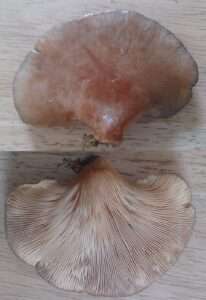
Name: Late oyster mushrooms (Sarcomyxa serotina)
Range and typical habitat(s): North American west, United States east of the Great Plains, widespread across Europe, extreme east Asia
Distinguishing physical characteristics (size, colors, overall shapes, detail shapes): At first glance the this looks like any other oyster mushroom, with its round, shelf-shaped appearance. However, where true oysters (Pleurotus spp.) tend to be gray or white in appearance, the slimy-textured cap of the late oyster can be anywhere from orange to olive-green to violet-tinted, and can grow up to six inches across. The gills are usually yellow to orange, and while some may remain single from the stipe to the edge of the cap, others fork at least once.
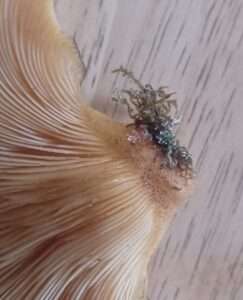
Young late oyster mushrooms may have edges that roll under, but when mature they open to a flatter shape, sometimes with a gently scalloped edge. The stipe is quite unique with its fuzzy texture, and is generally very short. The tightly-packed gills are adnate, meaning that they attach to the stipe with their entire width, rather than becoming shorter in height as they approach the stipe. Take a spore print of a late oyster mushroom, and you’ll find a cream to yellow print. The flesh does not bruise or otherwise discolor when damaged.
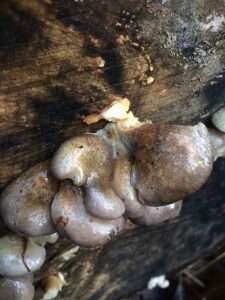 Like oyster mushrooms, late oysters grow in clusters on decaying hardwood trees, like maples and alders. They gain their “late” name for their tendency to fruit in fall to early winter; October to December is prime time for this fungus. Even in areas that receive frosts and freezes, the mushrooms may keep on growing in spite of the cold.
Like oyster mushrooms, late oysters grow in clusters on decaying hardwood trees, like maples and alders. They gain their “late” name for their tendency to fruit in fall to early winter; October to December is prime time for this fungus. Even in areas that receive frosts and freezes, the mushrooms may keep on growing in spite of the cold.
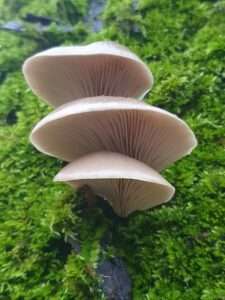
Other organisms it could be confused with and how to tell the difference: Again, true oyster mushrooms bear the most resemblance to late oysters. In addition to being less colorful–gray to white being most common–true oysters have a smooth rather than fuzzy stipe. Their spore print is usually white, occasionally with a slight purple tint. Finally, the gills of true oysters continue down the stipe (decurrent), while the late oyster’s gills stop at the stipe.
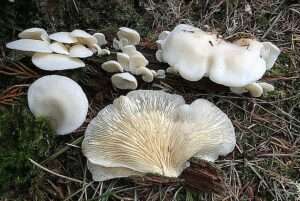
Angel wing mushrooms (Pleurocybella porrigens) are another white mushroom found growing on dead wood. They lack the late oyster’s color variety and have decurrent gills that produce white spores, and their flesh tends to be more delicate. Most importantly, angel wings grow on decaying conifers while late oysters grow on hardwood trees, and they fruit in late summer into fall, but not to winter. Angel wing mushrooms used to be considered edible, but a series of poisonings several years ago has put their edibility into question.
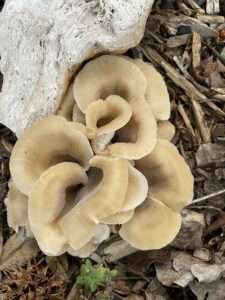
Shoehorn oyster mushrooms (Hohenbuehelia petaloides) may sometimes look a bit like a brown-tinted late oyster mushrooms, but look underneath and you’ll see the white gills are decurrent, and they have a white spore print. Also, they tend to grow on woody debris rather than tree trunks, and will fruit anywhere from spring through fall.
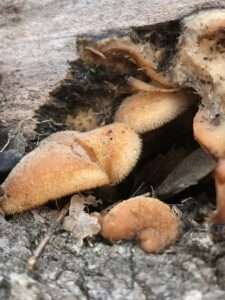
The only other significant inedible lookalike besides angel wings is the mock oyster (Phyllotopsis nidulans). The orange cap may look similar to an orange-colored late oyster, but it has a fuzzy texture all over instead of only on the stipe. The gills produce orange to peach spores, are decurrent, and not as tightly packed as on the late oyster. A strong stench is the best way to identify the mock oyster, and should you try eating one it has an equally unappealing flavor and tough texture.
Anything else worth mentioning? Late oyster mushrooms are considered edible, though with a rather bland, unexciting flavor. Their texture is good, though, and they lend themselves well to being vehicles for sauces and other flavoring agents. Some people report they can be bitter if the top layer is not peeled off, and it is strongly recommended that they be cooked longer than some other mushrooms, at least 15-20 minutes. This can reduce the chance of gastrointestinal upset, but as always it is best to only try a very small amount of a new mushroom when eating it for the first time, and you MUST make absolutely sure you are 100% certain that what you are about to eat is an edible species.
Further reading:
Late Fall Oyster: Identification, Foraging, and Preparing
Late Fall Oyster Mushrooms: Sarcomyxa serotina
Late Fall Oyster (Panellus serotinus) — Identification & Medicinal Benefits
Late Fall Oyster: Sarcomyxa serotina
